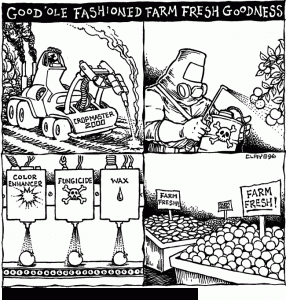By: Andreas Moritz
Book excerpt: Timeless Secrets of Health & Rejuvenation
According to Harvard nutritionist Jean Mayer, we would have enough food for the entire developing world if we ate half as much meat. Reducing meat production by merely 10 percent could release enough grain and other natural foods to feed 60 million people! Albert Einstein had this to say about vegetarianism: “Nothing will benefit human health and increase the chance for survival on Earth as much as the evolution to a vegetarian diet.” He predicted that producing and eating so much meat would literally kill us and our environment. Leo Tolstoy stated, “Vegetarianism is the taproot of humanitarianism.”
[Video removed from YouTube]
In this fiery and funny talk, New York Times food writer Mark Bittman weighs in on what’s wrong with the way we eat now (too much meat, too few plants; too much fast food, too little home cooking), and why it’s putting the entire planet at risk.
The world’s output of meat increased fivefold in the second half of the 20th century. Given the current trend, by 2050, the increases in meat production will have reached a point where we could feed 4 billion extra people with the plant food that is now being used to raise cattle. Only 10 percent of the protein and calories we feed to our livestock are recovered in the meat we eat. In the case of the United States, for the 20 million tons of humanly edible and nutritious protein that is fed to livestock yearly (apart from the waste products and drugs), only about 2 million tons of meat protein are obtained; and out of that amount, less than 27 percent can be utilized by the human body.
If you are concerned about the world’s survival, consider the following statistics:
- One acre of grain produces 5 times more protein than an acre of pasture set aside for meat production. An acre of beans or peas produces 10 times more protein and an acre of spinach 28 times more protein. Almost all land can be used for growing some crop or another.
- One portion of meat contains only 20 grams of protein, whereas a typical 100-gram portion of beans yields 35 grams of protein. The meat, however, costs about 20 times more than the beans do. Being a vegetarian saves not only lives, but also money.
- The food energy supplied by meat production uses 10 times more fossil fuel than the food energy supplied by plant production. Given the current shortage of fossil fuels on the planet, meat production may soon become unaffordable.
- The world’s livestock now produces at least 10 percent of all the greenhouse gases. In other words, emissions from livestock have become a significant source of atmospheric methane. As of 1990, domestic animals currently account for about 15 percent of the annual anthropogenic methane emissions, and the number has been steadily increasing ever since.
- 85 percent of the topsoil lost in the USA each year is directly associated with the raising of livestock. In this way, 4 million acres of cropland is destroyed every year. In the same way, precious rain forests have had to give way to satisfy the demand for more meat in the world.
- To grow one pound of wheat requires only 60 pounds of water, whereas the production of one pound of meat requires a staggering 50,000 pounds of water. To produce one pound of chicken, 1,800 pounds of water are needed. Large chicken slaughtering plants, in fact, expend up to 100 million gallons of water daily, enough to supply a city of 25,000 people!
- According to research published in Chemical & Engineering News, Vol. 85, No. 15, April 9, 2007: 34-35, roxarsone, an arsenic-based additive used in most chicken feed, could pose health risks to humans. Roxasone is used to promote growth, kill parasites and improve the color of chicken meat. Under certain conditions, which can occur within live chickens or on farm land, this compound converts into more toxic forms of inorganic arsenic. This form of arsenic has been linked to bladder, lung, skin, kidney and colon cancers, and low-level exposure can lead to partial paralysis and diabetes. Of course, arsenic is also a deadly poison. Over 70 percent of the 9 billion broiler chickens produced annually in the United States are fed roxarsone.
Watch Andreas speak about how “Humans are not made to eat Meat”
The meat production process is so wasteful and costly that, in order to survive, the meat industry needs hundreds of millions of dollars in tax subsidies every year. You never pay only for the meat you eat; the subsidies come out of your pocket. In 1977, the governments of Western Europe spent almost half a billion dollars purchasing farmers’ overproduction of meat and additional millions to store it. This trend has not been different in the United States and is worsening each year. All this is precious money lost, thereby heavily burdening every national economy. In this sense, meat consumption is directly impoverishing the wealthy nations. Any wars fought in the future will revolve about energy, food and water, all three of which are heavily wasted through meat production. The worldwide increase of meat consumption is driving the world closer and closer to the brink of international conflict.
This is an excerpt from Andreas Moritz‘s book Timeless Secrets of Health & Rejuvenation.
You may share or republish this article provided you clearly mention the name of Andreas Moritz and paste a hyper link back to the post:
https://www.ener-chi.com/meat-production-whats-wrong-with-what-we-eat/

